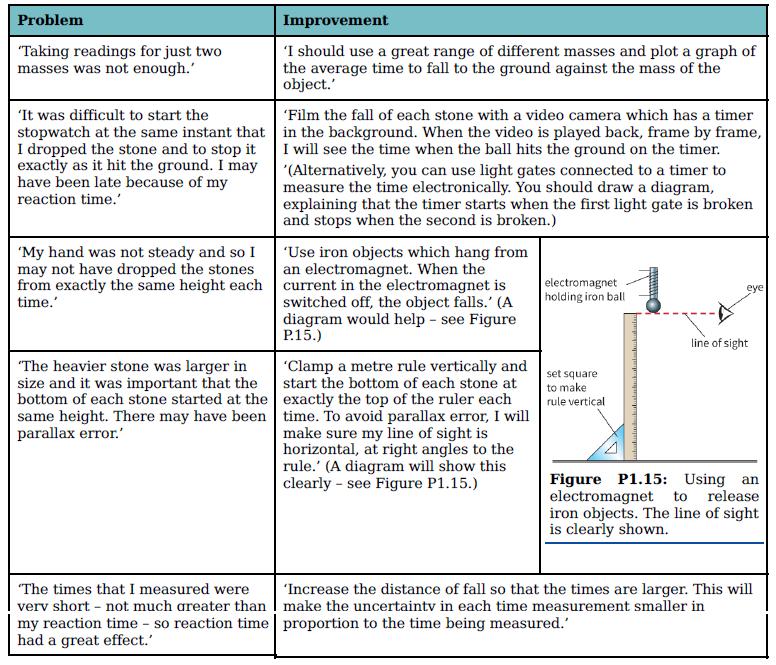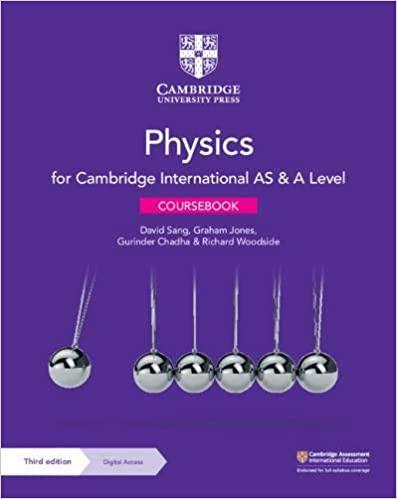Use a stopwatch and a metre rule to measure the average speed as an object falls from
Question:
Use a stopwatch and a metre rule to measure the average speed as an object falls from a table to the ground. What are the difficulties and how might they be reduced? Some of the suggestions will be the same as those in Experiment 2, but you should also consider difficulties in measuring the distance to the ground and how they can be avoided. Remember, rules have battered ends and the ends may not be at 0 and 100 cm.

Transcribed Image Text:
Problem Improvement "Taking readings for just two masses was not enough. 'I should use a great range of different masses and plot a graph of the average time to fall to the ground against the mass of the object.' 'It was difficult to start the stopwatch at the same instant that in the background. When the video is played back, frame by frame, I dropped the stone and to stop it exactly as it hit the ground. I may have been late because of my 'Film the fall of each stone with a video camera which has a timer I will see the time when the ball hits the ground on the timer. "(Alternatively, you can use light gates connected to a timer to measure the time electronically. You should draw a diagram, explaining that the timer starts when the first light gate is broken and stops when the second is broken.) reaction time.' 'My hand was not steady and so I may not have dropped the stones from exactly the same height each current in the electromagnet is 'Use iron objects which hang from an electromagnet. When the electromagnet holding iron ball eye switched off, the object falls.' (A diagram would help - see Figure P.15.) time.' line of sight "The heavier stone was larger in size and it was important that the "Clamp a metre rule vertically and start the bottom of each stone at bottom of each stone started at the exactly the top of the ruler each same height. There may have been time. To avoid parallax error, I will make sure my line of sight is horizontal, at right angles to the rule.' (A diagram will show this clearly - see Figure P1.15.) set square to make rule vertical parallax error.' Figure P1.15: Using an electromagnet iron objects. The line of sight is clearly shown. to release The times that I measured were verv short - not much areater than I make the uncertaintv in each time measurement smaller in my reaction time - so reaction time proportion to the time being measured.' had a great effect. 'Increase the distance of fall so that the times are larger. This will
Fantastic news! We've Found the answer you've been seeking!
Step by Step Answer:
Answer rating: 64% (14 reviews)
Difficulty It was difficult to start and stop the stopwatch at the same instant when the object is d...View the full answer

Answered By

Abdul Wahab Qaiser
Before working at Mariakani, I volunteered at a local community center, where I tutored students from diverse backgrounds. I helped them improve their academic performance and develop self-esteem and confidence. I used creative teaching methods, such as role-playing and group discussions, to make the learning experience more engaging and enjoyable.
In addition, I have conducted workshops and training sessions for educators and mental health professionals on various topics related to counseling and psychology. I have presented research papers at conferences and published articles in academic journals.
Overall, I am passionate about sharing my knowledge and helping others achieve their goals. I believe that tutoring is an excellent way to make a positive impact on people's lives, and I am committed to providing high-quality, personalized instruction to my students.
0.00
0 Reviews
10+ Question Solved
Related Book For 

Cambridge International AS And A Level Physics Coursebook
ISBN: 9781108859035
3rd Edition
Authors: David Sang, Graham Jones, Gurinder Chadha, Richard Woodside
Question Posted:
Students also viewed these Sciences questions
-
What are primary assurance properties? How might they be considered in developing an ISMS?
-
What are unusual items? How might they be reported on the income statement?
-
What are "junk bonds"? How might they be used in financing a corporation?
-
Consider an extendable hash structure where buckets can hold 3 search key values. The entries with the key values listed below are inserted in the following order: 57, 28, 26, 98, 38, 79, 7, 109, 30...
-
Fourth Street Lighting shows a net income of $224 000 for the previous year. If the contribution rate for the store was 40.3%, and the fixed cost was $315 000, what were last years sales?
-
The Bradley family owns 410 acres of farmland in North Carolina on which they grow corn and tobacco. Each acre of corn costs $105 to plant, cultivate, and harvest; each acre of tobacco costs $210....
-
A long, straight wire carrying a current of \(2.5 \mathrm{~A}\) to the left is placed directly below and parallel to the central axis of a solenoid that has 1000 windings per meter of length and a...
-
Manufacturing data for January and February in the Mixing Department of Kerwin Kleaning Products follow: All materials are added at the start of the process. Labor and factory overhead are added...
-
For a particular Java assembler interface, it is known that the operand stack size has the following probability distribution function: 0 1 2 3 4 . 2 5 . 2 0 . 1 8 . 1 7 . 2 0 What is the Expected...
-
Jimmy owns a garden in which he has planted N trees in a row. After a few years, the trees have grown up and now they have different heights. Jimmy pays much attention to the aesthetics of his...
-
Hang a mass from a spring or from a rubber band. Use a stopwatch to time the mass as it oscillates up and down. Measure the time for just one oscillation, the time for 10 oscillations and the time...
-
A rifle bullet is photographed in flight using two flashes of light separated by a time interval of (1.00 0.02) ms. The first image of the bullet on the photograph appears to be at a position of...
-
Problems 3140. The purpose of these problems is to keep the material fresh in your mind so that you are better prepared for later sections, a final exam, or subsequent courses such as calculus. Use a...
-
fatima is 2 5 years old and just learned that she is pregnant. Fatima is beginning to learn about all of the changes that will occur to her body during pregnancy. Which of the following occur to a...
-
A financial analyst notices that the same stock is trading for different prices on two different exchanges. The stock is trading for $100 on Exchange A and $102 on Exchange B. The analyst believes...
-
Chism states that "...the philosophy of teaching statements are descriptions of how the teachers think learning occurs, how they think they can intervene in this process, what chief goals they have...
-
What is the significance of legal citation in legal research? Explain
-
What tips did you learn when it comes to credit scores, in no less than two full paragraphs. https://www.youtube.com/watch?v=zgZN4Zm5GRM
-
A diver rises quickly to the surface from a 5.0-m depth. If she did not exhale the gas from her lungs before rising, by what factor would her lungs expand? Assume the temperature to be constant and...
-
How do network effects help Facebook fend off smaller social-networking rivals? Could an online retailer doing half as much business compete on an equal footing with Amazon in terms of costs? Explain.
-
The exact energy of a ground-state He atom is 79.01 eV. Calculate the correlation energy and the ratio of the correlation energy to the total energy for He using the results in Table 21.1. TABLE 21.1...
-
Write the Slater determinant for the ground-state configuration of Be.
-
Consider the molecular electrostatic potential map for the NH 3 molecule shown here. Is the hydrogen atom (shown as a white sphere) an electron acceptor or an electron donor in this molecule?
-
Share with your classmates a time when you saw a film or television program or another presentation experience that made you feel like you were engaged in a conversation. How did it make you feel?
-
Using the bivariate distribution for the pair of discretely distributed random variables (Y and Z), as given in the class notes - show that, for the fixed constant "d", E{d Y} = d E{Y} Note that this...
-
Write an SQL query to find the second highest salary from an employee table.

Study smarter with the SolutionInn App


